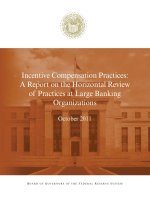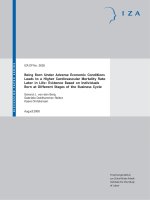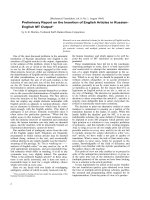Project Title Report On Ajinomoto Business Visit.pdf
Bạn đang xem bản rút gọn của tài liệu. Xem và tải ngay bản đầy đủ của tài liệu tại đây (685.89 KB, 23 trang )
lOMoARcPSD|38133502
Ho Chi Minh City University of Economics and Finance
Faculty of Economics
Project title: Report on Ajinomoto business visit.
Lecturer: Dr. Huynh Ai Van
Course code: MGT1127E
Class: B04E. Group: 6
School year: 2022 – 2023. Semester: 2A.
City. Ho Chi Minh, June 2, 2023
Downloaded by minhnhat08 nguyen ()
lOMoARcPSD|38133502
Contents
FOREWORD......................................................................................................................................1
CHAPTER I. ABOUT THE AJINOMOTO VIETNAM COMPANY...........................................................2
1. Formation and growth:..........................................................................................................2
2. Ajinomoto Vietnam's Vision, Mission, and Common Values-Creation Activities Male:.....2
CHAPTER II. THE ADMINISTRATION OF THE AJI-NGON SEASONING PRODUCING OPERATIONS..3
1. Delicious Aji seasoning items.................................................................................................3
2. Aji-Ngon seasoning production process................................................................................4
CHAPTER III. A REVIEW OF THE AJINOMOTO COMPANY’S OUTPUT QUALITY..............................6
1. Quality standards of Ajinomoto Corporation........................................................................6
1.1. Product quality.................................................................................................................6
1.2. Service quality..................................................................................................................8
CHAPTER IV. AJINOMOTO’S RESOURCES AND CAPABILITIES ARE COMPARED TO THOSE OF
COMPETITORS..................................................................................................................................9
1. Ajinomoto Company and competitors:.................................................................................9
CHAPTER V. APPLYING OPERATIONAL THEORIES TO THE PRODUCTION PROCESS OF THE
AJINOMOTO COMPANY.................................................................................................................14
1. Ajinomoto Company has applied many theories and efficient operating methods in its
production process, include as follow:......................................................................................14
1.1. Lean Manufacturing:......................................................................................................14
1.2. Lean Six Sigma:...............................................................................................................14
1.3. Total Quality Management (TQM):...............................................................................16
..................................................................................................................................................16
1.4. Research and development:..........................................................................................16
1.5. Training and developing human resources:..................................................................16
CHAPTER VI. PROPOSE THE IMPROVEMENT OF THE OPERATIONS OF THE AJINOMOTO...........17
REFERENCES...................................................................................................................................18
Downloaded by minhnhat08 nguyen ()
lOMoARcPSD|38133502
Downloaded by minhnhat08 nguyen ()
lOMoARcPSD|38133502
FOREWORD
Understanding operational management is important, but it is also important to put theory into practice
outside of the classroom. Practical experience is a crucial component of how we may apply the lesson
effectively because learning and doing go hand in hand.
We had the opportunity to visit the Ajinomoto Long Thanh facility (Dong Nai) in the field tour to this well-
known food manufacturing company in Vietnam. Here, we were given an overview of the formation and growth
of the company, led on a tour of the manufacturing and packaging facilities, and given the opportunity to
witness the most recent tools and technology in action. This is a very rewarding trip for us
We would like to thank the school for providing us with the opportunity to have actual touch with the
lesson before entering the report to show what we have learned during the trip. At the same time, we would
like to express our gratitude to Ms. Van for her guide, which helped us create the most detailed report.
Lecturer: Dr. Huynh Ai Van Page 1
Downloaded by minhnhat08 nguyen ()
lOMoARcPSD|38133502
CHAPTER I. ABOUT THE AJINOMOTO VIETNAM COMPANY
1.Formation and growth:
With a founding investment of more than $8 million USD, the Ajinomoto Vietnam Company is a 100%
foreign-owned subsidiary of the Japanese company Ajinomoto Group. With a total expenditure of up to 70
million USD for construction, operation, and market expansion, the company has gradually expanded and
increased its ability to produce products since its start. In addition to two production facilities, Ajinomoto Bien
Hoa Factory, which has been in operation since 1991, and Ajinomoto Long Thanh Factory, which has been in
operation since 2008, Ajinomoto Vietnam Company currently has two offices in Ho Chi Minh City and Hanoi.
Along with 60 sales locations and about 290 sales teams around the nation, the company also has three sizable
distribution centers in the provinces of Long Thanh, Hai Duong, and Da Nang.
2.Ajinomoto Vietnam's Vision, Mission, and Common Values-Creation
Activities Male:
- Vision: "Become the most loved and trusted company in Vietnam, with "Unique characteristics" in the
fields of food and health."
- Mission: "Through culinary culture and food source development, we contribute to Vietnam's further
development, to the happiness and health of the Vietnamese people."
- Ajinomoto Vietnam Company aspires to provide the Vietnamese people with a wide range of culinary
products and spices of the greatest quality, safety, and flavor in order to achieve this goal and mission.
Ajinomoto Vietnam's goods always aim at two great values:
+ Contribute to scrumptious meals and convenient cooking, so fostering family cohesiveness and
happiness;
+ Contribute to good nutritional value to health.
Lecturer: Dr. Huynh Ai Van Page 2
Downloaded by minhnhat08 nguyen ()
lOMoARcPSD|38133502
Figure 1. Ajinomoto factory in Long Thanh (Dong Nai)
CHAPTER II. THE ADMINISTRATION OF THE AJI-NGON
SEASONING PRODUCING OPERATIONS
1.Delicious Aji seasoning items
The first seasoning on the market to use Stew Bone Extract is Aji-ngon
seasoning, which is produced on-site at the Ajinomoto factory using modern
Japanese technology.
A unique bone and meat stewing process used in the Bone Broth Extract
manufacturing process preserves the natural sweetness of the bones and flesh
while industrializing the housewife's homemade broth-making process. The entire
production process is monitored by an extensive quality control system to ensure
that consumers are receiving high-quality, safe products.
Diagram 1. Process of Aji-ngon seasoning product
Lecturer: Dr. Huynh Ai Van Page 3
Downloaded by minhnhat08 nguyen ()
lOMoARcPSD|38133502
Input Transformatio Output
n process
Rib bones, ribs, Quality
shoulder lean Meat and bone assurance and
meat, pork thigh broth production food safety and
lean meat. process. hygiene
Clean water Thorough quality
Sugar, salt, Aji-ngon control for
starch, seasoning freshness,
monosodium production temperature,
glutamate process humidity, etc
Onion powder, Guaranteed
garlic powder characteristic
Oil taste and aroma
Other Nice packaging
seasonings
Machinery and
equipment.
Labor
2.Aji-Ngon seasoning production process
Production crew monitoring of safety and hygiene is always a critical element in delivering a clean and
safe product to customers. Before entering the production area, every worker goes through the identical
procedures: donning safety nets, helmets, and masks; donning clean clothes and shoes; wash their hands with
soap; and dry their hands.
Step 1: Receiving, checking and weighing materials.
The two most important components are meat and bone broth. Transfer to the Aji-Ngon workshop will
occur after direct factory production.
After passing rigorous quality checks, basic ingredients including sugar, salt, starch, and monosodium
glutamate are held in tanks and weighed automatically. The force sensor of the weighing device will enable
Lecturer: Dr. Huynh Ai Van Page 4
Downloaded by minhnhat08 nguyen ()
lOMoARcPSD|38133502
accurate measurement of the components of the Aji-Ngon seasoning. It was then put in the tank to finish
blending with the other spices.
Figure 2. Bones, marrow and flesh are examined visually and micro biologically, at Ajinomoto Long Thanh factory.
Step 2: Raw material grinding stage
Garlic powder, onion powder, and other spices are still weighed in specific ratios. Once the components
are well-combined and ready for grinding, store them in the big ingredients tank. To uniforming the size of the
raw materials in advance of mixing and homogenization, the raw materials will be stored in the mill for
crushing.
Lecturer: Dr. Huynh Ai Van Page 5
Downloaded by minhnhat08 nguyen ()
lOMoARcPSD|38133502
Step 3: Mixing and homogenizing stage
The materials will next go through a process of mixing and homogenization after being ground. The
essential ingredients, including bone broth and meat, are blended in this important step. Bone broth and meat
are packaged and kept in cold storage to guarantee the best products. The team will move the meat and bone
broth from here to the Aji-Ngon workshop.
The homogenization process improves cohesiveness, generates the appropriate moisture, and imparts the
unique taste of the constituent mixture. This is a demanding phase that demands not only speed but also the
experience of the operational and supervising team to assure the granulation stage.
Step 4: Granulation and drying stage.
The granulation process starts when the powder is put in the
granular machine after homogenization. Particles of a relatively
uniform size have now been created by blending the various
components. Following that, the Aji-Ngon seeds are fed through a
deep-bed drying device using hot air. The water within the seeds
will start to evaporate once the temperature reaches 100 degrees.
Finally, the temperature is dropped to allow the grain to cool, and
while it is drying, it is maintained at a constant, moderate
temperature to preserve the flavor and color of the ingredients. Figure 3. A close-up of the granulation process
of Aji-ngon® seasoning seeds, at Ajinomoto
Long Thanh factory
Step 5: The stage of turning and spraying oil.
The Aji-Ngon seeds are taken to a filter mechanism after drying to be sorted by size, ensuring that they
are of an even and appealing size. Sorted particles of a standard size are delivered to the oil injection portion.
Each Aji-Ngon seed will now receive a thin coating of oil from oil jets, which will enhance the seasoning's gloss
and color. At this point, Aji-Ngon spice will help create a nice and attractive golden coating for the food.
Step 6: Packing
The Aji-Ngon seasoning seed box stacks will then be placed in the warehouse by the robot. The items will
then be transported to the testing facility, where they will be precisely weighed, carefully scrutinized for
appearance, and then chosen, packed, and transported to the distribution facility.
Lecturer: Dr. Huynh Ai Van Page 6
Downloaded by minhnhat08 nguyen ()
lOMoARcPSD|38133502
CHAPTER III. A REVIEW OF THE AJINOMOTO COMPANY’S
OUTPUT QUALITY
1. Quality standards of Ajinomoto Corporation
The Ajinomoto Corporation Quality Standards are designed to ensure that products meet the quality
expected from the Ajinomoto Group brand. These are strict standards from training, labeling, packaging, to
traceability, etc.
1.1. Product quality
- Quality assessment standards: The Company is dedicated to understanding the needs of customers as
well as providing products and services that satisfy customers. They proactively provide relevant information
that suits clients and continuously improve reputation. They do not compromise on safety issues, conduct the
most thorough research and surveys possible and strictly follow the laws and regulations, while always
providing products and services of uniform quality. The company also guarantees quality through the Ajinomoto
quality assurance system (ASQUA), based on the concepts described in the ISO International standard.
Figure 1. Components of ASQUA
- Standards for quality control of raw materials and standards for safety and hygiene of food packaging
materials:
+ Technical quality requirements, management requirements on hygiene and safety for packaging in
direct contact with products, etc.
- GMP standards for food, GMP standards for pharmaceutical products and standards for Food Safety
Management System (including HACCP) :
Lecturer: Dr. Huynh Ai Van Page 7
Downloaded by minhnhat08 nguyen ()
lOMoARcPSD|38133502
+ The basic operating and environmental conditions necessary for the production of safe food.
Lecturer: Dr. Huynh Ai Van Page 8
Downloaded by minhnhat08 nguyen ()
lOMoARcPSD|38133502
- Food defense standards:
+ Measures to prevent the intentional introduction of impurities into food. The Group will check all
stages from the procurement of raw materials until the product reaches the consumer, in order to
prevent anyone from intending to put toxins or other impurities in the food.
1.2. Service quality
- Customer Service Center of Ajinomoto Vietnam Company wishes to have the best service to customers
through consulting activities on product use, collecting and processing customer comments, thereby
contributing to product improvement and development, and better customer service.
- Ajinomoto has been applying a code of conduct on customer satisfaction. The rules are as follows:
+ Ajinomoto provides safe and reliable products and services to customers.
+ Ajinomoto responds to complaints, requests and inquiries from customers accurately, quickly and
politely.
+ Ajinomoto respects customers' opinions and tries to use all input information to add value to
products and services.
+ Ajinomoto proactively discloses relevant information to customers.
+ Ajinomoto adheres to voluntary internal regulations and standards regarding the protection of
customers' interests
- Standards for effective handling and the use of “Customer Feedback”:
+ Customer feedback, first response time, customer effort and sympathy metrics, customer
problem resolution rate and customer abandonment rate.
Figure 2. Consultant Ajinomoto's guest
Lecturer: Dr. Huynh Ai Van Page 9
Downloaded by minhnhat08 nguyen ()
lOMoARcPSD|38133502
CHAPTER IV. AJINOMOTO’S RESOURCES AND CAPABILITIES
ARE COMPARED TO THOSE OF COMPETITORS.
1. Ajinomoto Company and competitors:
Ajinomoto Vedan Maggi
- The total number of
Human employees working at - The number of employees - Currently Maggi Company
Resources Ajinomoto Vietnam is more in the Company are more has more than 2000
than 2.300 people. than 3000 people. employees.
- At Ajinomoto Vietnam, - The company has a - Invest heavily in training
focus on training and training plan to ensure the and improving professional
developing staff capacity. implementation of skills such qualifications for employees.
as informatics, production
- Always create a healthy techniques, maintenance and - Having a team of highly
working environment, repair of machines, qualified staff, good
encourage employees to occupational safety and communication skills,
contribute creative ideas. hygiene, fire prevention, etc. teamwork skills and a sense of
responsibility for the assigned
work.
- Regularly pay attention to
implementing initiatives and
activities to take care of physical
and mental health for all
employees.
- The company sets out
policies include:
• Create favorable working
conditions for pregnant and
lactating female employees.
• Educate and improve
Lecturer: Dr. Huynh Ai Van Page 10
Downloaded by minhnhat08 nguyen ()
lOMoARcPSD|38133502
nutrition for all employees.
• Organize periodical health
check-ups and consultations
for employees.
Business - Ajinomoto Vietnam - Vedan Vietnam Company - Maggi is a brand acquired
networks Company has two offices in was established in 1991. by Nestlé in 1947.
Ho Chi Minh City and Hanoi. - Nestlé Group was born in
- There are 2 branches in 1866 and has its head office in
- There are two Hanoi and Binh Phuoc. Vevey, Switzerland.
manufacturing plants - The largest food and
including Ajinomoto Bien Hoa - In the process of beverage company in the
Factory operating since 1991 expanding investment scale world
and Ajinomoto Long Thanh and business development, - Has a wide production and
Factory operating since 2008. Vedan Vietnam has also built business network in 191
a series of agent systems and countries with 500 factories.
- The company has 3 large distribution channels
distribution centers in Long throughout the country.
Thanh, Hai Duong and Da
Nang provinces with 60
business branches and nearly
290 sales teams nationwide.
Capital and - With an initial investment - Although entering the - Maggi's strategy is only
market of more than $8 million USD, Vietnamese market after aimed at the segment of
Ajinomoto Vietnam Company Ajinomoto, Vedan has a consumers with economic
is a 100% foreign-invested higher market share than conditions, but this audience
subsidiary of Ajinomoto Ajinomoto and used to be the only accounts for 17-23%,
Corporation Japan. leader in the Vietnamese MSG compared to Ajinomoto,
market. However, Vedan's which is preferred by
- A total cost of building, policy on environmental everyone because of its low
operation, and market growth protection is not good, price, suitable for all
Lecturer: Dr. Huynh Ai Van Page 11
Downloaded by minhnhat08 nguyen ()
lOMoARcPSD|38133502
of up to 70 million USD, the leading to many negative audiences products are of
firm is continuously increasing aspects to the market. high quality.
and enhancing product
manufacturing capacity. - Maggi doesn't have a
synchronous advertising
strategy like Aji-Ngon.
- Spending $5 million on
garbage sorting and recycling
are how Ajinomoto
differentiates itself from its
rivals.
- Even if significant
investment in the
environment will lead to
increased costs and reduced
profits (actually), Ajinomoto
has succeeded in capturing
the trust of consumers and
maintaining a leading position
in the industry MSG.
Resources - They make extensive use - Before Vietnam's - Maggi uses very little
of agricultural raw resources electricity supply is still nutrients from bones and
obtained from nearby farms, limited, Vedan has developed meat in MSG products
such as sugar cane and a steam-based power
tapioca starch. generation system the - Focus on mainly European
world's energy development markets, not Vietnamese
- The business has put its trend. consumers.
proposal to enable farmers
growing ami-ami fertilizer in - Provide stable power - Maggi lost its position in
the form of molasses made source for production the Vietnamese market.
from waste created during activities from Vedan Vietnam
productions to use in a trial power plant. - The advertisement
emphasizes the taste of the
food rather than providing
Lecturer: Dr. Huynh Ai Van Page 12
Downloaded by minhnhat08 nguyen ()
lOMoARcPSD|38133502
runs into action. - The location of the nutrition
headquarters on the Thi Vai - Is much inferior to
- Utilize wise policies to River brings abundant
gain an edge over suppliers, resources to Vedan A great Ajinomoto in the Vietnamese
reduce reliance, and create advantage compared to market.
enduring bonds with farmers. Ajinomoto.
- Develop a market for - The economic crisis in
fertilizer products and a 2006 with the discharge of
supply of sustainable wastewater into Thi Vai River
manufacturing materials. was slapped causing
serious impact on finance and
- Always focus on investing brand.
in technology and raw
materials. - Customers lose trust.
- Using the technology of
extracting bone broth and
meat in place helps to reduce
the cost of raw materials and
save time.
Enterprise - The international - Brands under Nestle - Maggi’s business is not
capacity corporation Ajinomoto makes launching new products strong in all areas it operates
the most of its parent deprive sales of old products
companies resources as well total revenue stagnates, - Have not reached its full
as those of the nation where falling into an imbalance potential.
the subsidiary is situated. between brands.
- There are still many
- Utilize Vietnam's plentiful problems to solve such as a
raw materials wisely and weak reputation, above-
invest in a large pool of average revenue, large debt, a
young, talented workers. short supply chain and a lack
of finance.
Lecturer: Dr. Huynh Ai Van Page 13
Downloaded by minhnhat08 nguyen ()
lOMoARcPSD|38133502
- Integrating the
advantages of an excellent
corporate governance model,
cutting-edge technology, and
advantageous production and
consumption circumstances,
bringing the firm numerous
advantages and pursuing
shared goals in Vietnam and
Japan.
In summary, in terms of resources and market, Ajinomoto is more appreciated than Vedan and Maggi
thanks to constantly expanding, improving production capacity, investing heavily in products, putting the health
and interests of consumers first used on top. In addition, Ajinomoto also promotes investment to train, care and
bring many benefits to employees with many incentive policies and good benefits. From there, bring a lot of
value to the company and create a business that stands out from the competition.
Currently, consumers tend to use and consider product selection based on quality. Therefore, Ajinomoto
Company is the first choice of consumers today. The company is constantly improving on packaging, materials
and technology to produce quality products to serve consumers.
Lecturer: Dr. Huynh Ai Van Page 14
Downloaded by minhnhat08 nguyen ()
lOMoARcPSD|38133502
CHAPTER V. APPLYING OPERATIONAL THEORIES TO THE
PRODUCTION PROCESS OF THE AJINOMOTO COMPANY
1.Ajinomoto Company has applied many theories and efficient
operating methods in its production process, include as follow:
1.1. Lean Manufacturing:
The company adopts lean manufacturing methods to
eliminate unnecessary activities, reduce waste and increase
productivity. Specifically:
- Ajinomoto Company has applied advanced and
environmentally friendly fermentation technology.
Helping the company to consume less input materials,
create more products and simplify the production process with
fewer steps. From there, the production becomes more efficient
and increases the competitive advantage for the Company.
1.2. Lean Six Sigma:
The company uses Lean Six Sigma to optimize production processes, reduce waste, and shorten
production cycles right from the start. For example, promoting production according to a closed dual biological
cycle helps to strictly manage the source of raw materials, improve the yield and quality of crops, thereby
ensuring a sustainable source of raw materials for Company’s production process.
Figure 1.The closed biological cycle
Lecturer: Dr. Huynh Ai Van Page 15
Downloaded by minhnhat08 nguyen ()
lOMoARcPSD|38133502
Figure 2. The closed biological cycle
Represents the company's continuous efforts to develop and change production techniques to
conserve energy and resources such as using renewable energy, investing in existing cooling and water
treatment systems grand. Since then, they have been successful in implementing 1 of the 7 clean production
targets: on-site recovery/reuse.
Lecturer: Dr. Huynh Ai Van Page 16
Downloaded by minhnhat08 nguyen ()
lOMoARcPSD|38133502
1.3. Total Quality Management (TQM):
The company implements TQM to ensure the quality of its
goods and services while increasing output and reducing expenses.
To guarantee product quality and food safety, Ajinomoto Company
implements quality management systems like GMP (Good
Manufacturing Practices), HACCP (Hazard Analysis and Critical
Control Points), OHSAS 18001 (Health and Safety Management
System), ISO 9001 (quality management system), and ISO 14001
(Environmental management system).
Figure 3. ASQUA frame
1.4. Research and development:
Ajinomoto invests heavily in research and development to improve production processes and products.
They use advanced technology and expertise to create new products and optimize production processes.
1.5. Figure 4. Using advanced technology to enhance deliciousness
Training and developing human resources:
Ajinomoto appreciates the role of human resource in the production process and understands that
training and human development is an important factor to improve product quality and increase production
efficiency. Thus, Ajinomoto invests heavily in training and human resource’s development, providing its
employees with intensive training, enhancing their professional skills and helping them develop their careers. In
addition, Ajinomoto also creates conditions for young employees to develop themselves and advance in the
company.
Lecturer: Dr. Huynh Ai Van Page 17
Downloaded by minhnhat08 nguyen ()









